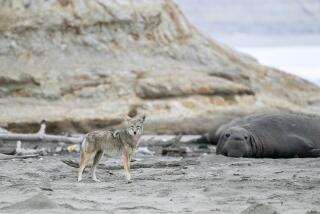Some Arctic seals now officially listed as threatened with extinction
- Share via
First came the polar bear. Now, the federal government has added two other marine mammals to the list of creatures threatened with extinction because of vanishing sea ice in a warming Arctic.
The National Oceanic and Atmospheric Administration has officially listed bearded seal and the ringed seal as threatened under the Endangered Species Act.
The reason is not inadequate supplies of fish and other food for these seals, or excessive hunting by humans. It’s the loss of their sea ice habitat.
Ringed seals give birth and nurse their pups in snow caves built on ice floes. Warming temperatures bring less snow and more rain, causing these snow caves to collapse and leaving pups vulnerable to freezing to death.
Bearded seals, with thick whiskers that help them find crabs, clams, cod and other bottom-dwelling prey, also give birth and nurse their pups on pack ice over shallow waters near food sources.
This September, the Arctic sea ice receded to record low levels, a troubling trend for sea ice-dependent animals.
“Sea ice is projected to shrink both in extent and duration, with bearded seals finding inadequate ice even if they move North,” NOAA Fisheries said in announcing that two distinct populations of bearded seals and four subspecies of ringed seals qualified as threatened with extinction.
A team of federal scientists, said Jon Kurland, protected resources director for NOAA Fisheries’ Alaska region, “concluded that a significant decrease in sea ice is probable later this century and that these changes will likely cause these seal populations to decline.”
Unlike the fight over the polar bear listing, the fate of the seals garnered little attention. NOAA’s Fisheries, the agency in charge of protecting most marine mammals, finalized the listing just before Christmas. It was timed to meet a court-ordered deadline that stemmed from a petition by the nonprofit Center for Biological Diversity.
It’s part of the center’s broader campaign to push the federal government to designate Arctic sea ice as critical habitat and then take steps to protect it. The only known way to do that is to reduce emissions of planet-warming carbon dioxide and other greenhouse gasses.
ken.weiss@latimes.com





